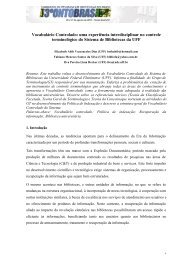6Sou, então, pintura.pdf - Repositório da Universidade Federal ...
6Sou, então, pintura.pdf - Repositório da Universidade Federal ...
6Sou, então, pintura.pdf - Repositório da Universidade Federal ...
Create successful ePaper yourself
Turn your PDF publications into a flip-book with our unique Google optimized e-Paper software.
Palavras-chave<br />
auto-retrato<br />
Iberê Camargo<br />
tempo na <strong>pintura</strong><br />
Key words<br />
self portrait<br />
Iberê Camargo<br />
time in painting<br />
Palabras-clave<br />
autorretrato<br />
Iberê Camargo<br />
tiempo en la <strong>pintura</strong><br />
Recebido em<br />
01/10/2004<br />
Aprovado em<br />
12/01/2005<br />
138<br />
Resumo<br />
O artigo analisa auto-retratos de Iberê Camargo, fixando-se especialmente<br />
nos auto-retratos de 1943 e de 1984, em que a questão do<br />
tempo se manifesta tanto na cronologia que diferencia as duas concepções<br />
de <strong>pintura</strong> quanto na gestuali<strong>da</strong>de que marca o ritmo e o an<strong>da</strong>mento<br />
como categorias enunciativas <strong>da</strong> <strong>pintura</strong>. Se no auto-retrato de<br />
1943 o ritmo é suave, quase etéreo, criando efeitos de harmonia e<br />
integração, no quadro de 1984 a gestuali<strong>da</strong>de brusca acelera e confunde<br />
o tempo <strong>da</strong> <strong>pintura</strong>, conferindo-lhe um an<strong>da</strong>mento veloz e um<br />
efeito de inacabamento e imperfeição. É a inscrição do tempo na matéria<br />
pictórica que transforma a representação, alterando assim a relação<br />
intersubjetiva entre observador e pintor.<br />
Abstract<br />
The paper analyses Iberê Camargo’s<br />
self-portraits, in particular<br />
his 1943 and 1984 paintings,<br />
in which the issue of time<br />
manifests itself both in the chronology<br />
which distinguishes the<br />
two conceptions of painting and<br />
in action which marks the rhythm<br />
and pace as enunciative categories<br />
of painting. In the selfportrait<br />
of 1943 the rhythm is<br />
soft, almost ethereal; in the 1984<br />
painting, the abrupt action<br />
accelerates and disarrays the time<br />
of the painting, resulting in a fast<br />
pace and an effect of unfinishness<br />
and imperfection. It is the<br />
inscription of time in the pictorial<br />
matter which transforms representation,<br />
altering, in this way, the<br />
intersubjective relationship<br />
between the painter and the<br />
observer.<br />
Resumen<br />
ALEA VOLUME 7 NÚMERO 1 JANEIRO – JUNHO 2005<br />
Este artículo analiza autorretratos<br />
de Iberê Camargo, en particular<br />
los autorretratos de 1943 y de<br />
1984. El tema del tiempo se<br />
manifiesta tanto en la cronología<br />
que diferencia dos concepciones<br />
de <strong>pintura</strong> como en la gestuali<strong>da</strong>d<br />
que marca el ritmo y el desarrollo<br />
como categorías enunciativas de<br />
la <strong>pintura</strong>. Mientras que en el<br />
autorretrato de 1943 el ritmo es<br />
suave, casi etéreo, creando efectos<br />
de armonía e integración, en el<br />
cuadro de 1984 la gestuali<strong>da</strong>d<br />
brusca acelera y confunde el<br />
tiempo de la <strong>pintura</strong>, resultando<br />
en un desarrollo veloz y en un<br />
efecto inacabado de imperfección.<br />
La inscripción del tiempo en la<br />
matéria prictórica transforma la<br />
representación y altera de esta<br />
forma la relación intersubjetiva<br />
entre observador y pintor.








